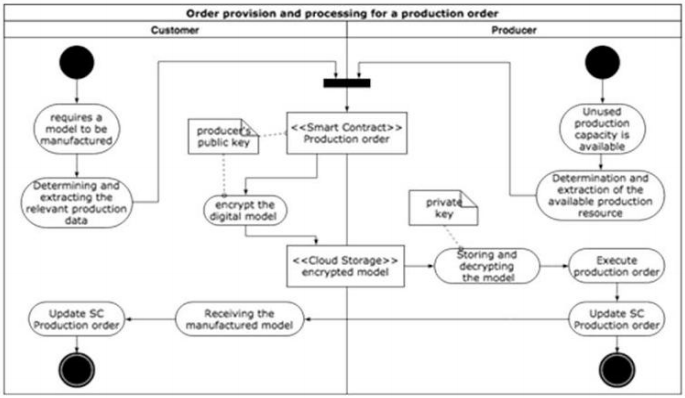Blockchain, the underlying technology of decentralized cryptocurrency Bitcoin, makes it possible for all members of a network to process transactions in a decentralized, transparent manner that is free from tampering. The technology stores a series of data sets, or blocks, containing transactional data, through an individual concatenation (hash values) on the preceding set. This forms a connection, or chain, between the blocks, which are then stored within the data set in a secure transfer.
Recently, we’ve been seeing increased interest in incorporating Blockchain technology into the 3D printing industry, from being used in a military testing capacity to storing data of 3D printed aircraft parts. A pair of researchers – Wjatscheslav Baumung from Germany’s Reutlingen University and Vladislav V. Fomin from both Vilnius University and Vytautas Magnus University in Lithuania – are looking to increase efficiency in the 3D printing business world by incorporating Blockchain.
The two wrote a paper, titled “Increasing the Utilization of Additive Manufacturing Resources through the Use of Blockchain Technology for a Production Network,” that further explains their research.
The abstract reads, “The blockchain technology enables a common data basis between the participants. Entries are logged and the authenticity of the participants is guaranteed. In the case of a relationship between customers and producers, this would lead to verifiable cooperation, which would be a major step as companies enter into service contracts based on the flow of many small transactions through communication. This paper proposes an architecture that enables the creation and processing of orders between the customer and producers via a blockchain-based production network. The handling of larger files which are traceable via the blockchain is also shown and the use of a public or permissioned blockchain for an application case is also considered.”
 Blockchain is thought to be one of the more important technologies in the future for many market domains, mainly due to its pure storage of transactions. Companies attempting to adopt technology like 3D printing have several challenges in doing so, such as training employees, costly investments at the start, and especially, as the paper puts it, “the risk of unused capacity at low capacity utilization.”
Blockchain is thought to be one of the more important technologies in the future for many market domains, mainly due to its pure storage of transactions. Companies attempting to adopt technology like 3D printing have several challenges in doing so, such as training employees, costly investments at the start, and especially, as the paper puts it, “the risk of unused capacity at low capacity utilization.”
“Especially high market prices of suppliers prevent access to the integration of innovative production technologies into the own added value,” Baumung and Fomin wrote in the paper. “To overcome this problem, the capacity utilization of production lines within a company must be analyzed and optimized in the best possible way. For cross-company and cross-industry use, product and order data must be mapped in an access-safe manner in order to offer new potential benefits.”
The amount of necessary organization it takes to outsource production orders can be immense, which often forces companies to build more production capacity than they really need in order to meet delivery dates – a breeding ground for inefficiency if there ever was one. The researchers came up with a list of research questions stemming from these issues:
- How can companies offer innovative production capacities to many users without intermediaries?
- Can Smart Contracts (SC) be used to process orders between manufacturers and customers?
- Which would be more suitable for production networks – public or private Blockchain?
- How does one set up a secure data exchange for larger data volumes for models to be produced in connection with the Blockchain?
SC are computer programs meant for mapping legal contracts to check compliance, which provides manufacturing companies with new applications and perspectives since important data like 3D printing designs and orders are able to be transmitted across the boundaries of the company itself. Blockchain can protect the whole production chain from unauthorized access, which increases network cooperation, security, and efficiency.

Architecture of a distributed production network for order creation and processing
between customer and manufacturer.
“In this article, we explain how blockchain technology can be used to build up the joint use of production data for efficient utilization of the capacities in a production network using the additive manufacturing facilities as an example,” the researchers explained in their paper. “We propose an architecture that connects manufacturing companies and customers without middlemen while at the same time enables economic optimization of production capacities via an open block-chain-based production network with secure product and order data transfers. We also address the problem of handling large amounts of data between the respective parties. For this purpose, a blockchain-based mechanism is presented in which data is stored outside the blockchain, but can still be traced and stored in a secure manner via the blockchain.”
The two presented a proof-of-concept prototype for the proposed mechanism and structure, and the architecture was validated on a public blockchain. They developed a web portal for the purposes of extracting production data and communicating with the blockchain networks. This allowed the data stored in the cloud, and in the blockchain itself, to be visualized, and also allowed for automated data extraction from the necessary 3D models.
Baumung and Fomin concluded, “Further research should be done to consider the presented architecture in relation to other participants in the production chain. It would also make sense to consider the approach presented in connection with Internet of Things (IoT) in order to further automate the process flow and reduce the effort for the producer to participate.”
Discuss this story and other 3D printing topics at 3DPrintBoard.com or share your thoughts in the Facebook comments below.
Subscribe to Our Email Newsletter
Stay up-to-date on all the latest news from the 3D printing industry and receive information and offers from third party vendors.
Print Services
Upload your 3D Models and get them printed quickly and efficiently.
You May Also Like
3D Printing News Briefs, July 2, 2025: Copper Alloys, Defense Manufacturing, & More
We’re starting off with metals in today’s 3D Printing News Briefs, as Farsoon has unveiled a large-scale AM solution for copper alloys, and Meltio used its wire-laser metal solution to...
Etsy Design Rule Change Reduces Selection of 3D Printed Goods
Online marketplace Etsy has implemented a rule change requiring all 3D printed goods on the site to be original designs. The update to the site’s Creativity Standards states, ¨Items produced using...
Siraya Tech Introduces New Elastomer 3D Printing Materials, Including Foaming TPU
California company Siraya Tech, founded in 2019 with a focus on material science, customer focus, and agility, develops high-quality 3D printing materials that meet the needs of creators, hobbyists, and...
3D Printing News Briefs, April 12, 2025: RAPID Roundup
The news from last week’s RAPID+TCT in Detroit just keeps on coming! That’s why today’s 3D Printing News Briefs is another RAPID Roundup of more exciting announcements from the trade...


































